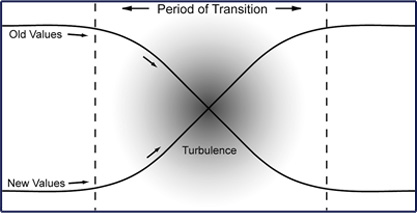Chapter 1
Imagine an ocean moment: two waves converging in the same time and space. One is powerful but subsiding, the other just gathering momentum and presence but not yet cresting. At the moment of their meeting they are nearly equal in amplitude and infl uence. As they cross, who can say which is rising, which descending? In that moment only the chaos of wave interference exists.
Now imagine modernity as a powerful wave of cultural values that crested half a century ago and is slowly beginning to subside. At the same time, a second wave of countervailing values rises equally slowly, building until its crest begins to rival the declining energy of the older wave (see fi g. 1.1 on the following page).
In Western culture the modern wave has long been dominant. Deeply rooted in classical antiquity and European history, the modern wave has profoundly shaped every culture in the world. In our own time, however, we have begun to sense the weakening of its infl uence and to recognize the growing strength of a challenging newer value wave.
This younger wave represents positive change. It is the wave of future possibility in the present, the advent of a cultural evolutionary transformation.

Figure 1.1 . Two Waves
Sea Change: The Good News
Not long ago, my wife and I were joined by two of our adult daughters as we rewatched a few hours of a wonderful video series. David Halberstam’s
The Fifties is an engaging but often critical portrait of the decade, based on a renowned journalist’s celebrated book. Different chapters address American attitudes in the 1950s toward racism, sexuality, advertising, suburbia, war, and so on. What made watching with our daughters so amazing was the discovery that while my wife and I had lived through the period and somehow outgrown or overcome many of the more disturbing sociocultural attitudes depicted, these young women had never harbored them at all.
They alternated between hysterical laughter at some of the depictions of American women and outright horror at the stark images of American racism. Well-educated young people, they nevertheless asked again and again, “Was it really ever like that?”
I often suggest that those who are skeptical about the idea of cultural evolution should consider the differences in values that separate them from their parents or grandparents on the one hand and from their own children on the other. Attitudes toward other races, other religions, and other cultures make good starting points for such comparisons. Ideas about justice and the human relationship to the Earth offer others. Most of us will have no trouble recognizing a significant cultural shift.
As the long-dominant older wave loses amplitude and the newer one surges, we cross the threshold into an interesting time. The cultural critique —of patriarchy, the legitimacy of war, ecological exploitation and pollution, racism, injustice, religious exclusivism, and imperialism—has arguably never been more pronounced. At the same time, we’ve begun to explore and even embrace emerging values including nonviolent conflict resolution, universal human rights, social and economic justice, ecological sustainability, and interreligious harmony.
But the passage is anything but straightforward. The interference of two culture waves unleashes both apparent chaos and emerging order. This dynamic creates the signature turbulence of a sea change: a profound alteration of cultural values toward a better fit with current realities. Sea changes are rare—in this book, I identify only four since human prehistory. They are daunting but richly creative periods, with at least three recognizable benchmarks:
• a dramatic increase in cultural complexity;
• a growing awareness of the interdependence of all with all; and
• a variety of new multiperspectival approaches to knowledge and action.
Never easy transitions, such evolutionary shifts in values produce profound inspiration and originality and, at the same time, cultural confusion and identity crisis. And, of course, the widespread emergence of new values and new ways of thinking always threatens established structures of power, thus adding a dangerous intensity to an already-volatile cultural mix.